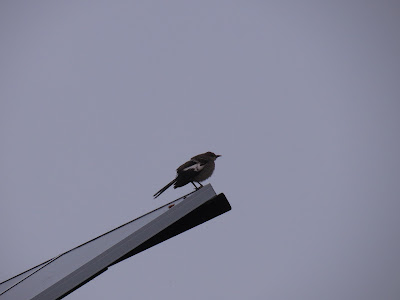Northwestern Ontario, also known as "Sunset Country" is where I've spent the last two and a half weeks travelling with Peter Mills. Ideally I would be on my way back along the north shore of Lake Superior right now (
a spectacular birding destination at this time of year), but we are currently stuck in Atikokan, just west of Quetico Provincial Park, awaiting car repairs. There are worse places to be stuck though, where you would not see birds like this:
In the vast expanse of boreal forest, the open habitats in and around towns are an oasis for open country birds like sparrows, larks, pipits and longspurs. The number of sparrows around Atikokan right now is mind-boggling, and this far west Harris's Sparrows are reasonably common. This big and boldly marked sparrow is very rare in Southern Ontario as it migrates primarily west of Lake Superior. This bird below was resting on a train car parked at the railyard in town:
Horned Larks, Lapland Longspurs and American Pipits can be found on practically any open ground. Today we had a flock of longspurs like the one below on the front lawn of the Beer Store in town!
A big surprise has been two sightings of Sedge Wrens, normally a species that is very hard to see, and also one I thought migrated earlier in the fall.
Another surprise was this Northern Mockingbird in the town of Silver Islet near Thunder Bay. I think this is a pretty big rarity for the area.
The Mountain Ash crop along the north shore of Lake Superior is spectacular, and some Ring-billed Gulls at Sleeping Giant Provincial Park were actually resorting to landing in trees to take advantage of it.
I've been seeing Lincoln's Sparrow in larger numbers and in more open habitat than I'm used to in Southern Ontario.
I've spent lots of time looking at stuff other than birds of course! Snowshoe hares are common, and this one seems to be changing to its winter coat earlier than the others I've seen.
Once you get far enough north and west, Least Chipmunks join the typical Eastern Chipmunk. Least Chipmunks are smaller, with a longer tail, bolder stripes on the face, longer stripes on the back and a more rufous colour overall. These cute little guys have definitely been one of the highlights of the trip!
The odeing was much better than I expected, presumably due to the very warm fall, with the first frost being only a couple of nights ago.
A great species only barely making it South to the shore of Lake Superior is Sedge Darner. Amazingly, this species breeds in pools along the rocky shoreline, as seen below in Marathon!
Meadowhawks are the little red or yellow dragonflies that are everywhere in August and September. Further north however, the Black Meadowhawk is all black as a mature male. We have seen an amazing six species of meadowhawk on this trip, also including White-faced, Cherry-faced, Autumn, Saffron-winged and Band-winged.
Another northern darner is the unique Zigzag. The thoracic stripes, so vital in identifying members of this genus (
Aeshna), are so thin as to be almost absent in this species.
Boreal Snaketail is another northern dragonfly, found along rivers and streams south to about Algonquin Park (where I have only seen them once).
There are four reptiles and amphibians found in Northwestern Ontario but not further south and east. Of them, we saw Central Newt and Western Painted Turtle (photo below), but have missed Boreal Chorus Frog and Red-sided Garter Snake.
Ouimet Canyon north of Thunder Bay is spectacular and a highly recommended stop along this route.
While there, I noticed Fragrant Cliff Fern (
Dryopteris fragrans) frowing on the cliff face, readily recognised by the "skirt" of dead fronds.
A common understory shrub in Quetico Provincial Park is Canada Yew (
Taxus canadensis). Although other yews may be trees, this, our only native species, is never more than a sprawling shrub.
Although they dominate forests further south, the only common maple here is Mountain Maple (
Acer spicatum), which rarely grows more than three or four metres tall.
Hopefully I'll have more exciting stuff to post soon!













































